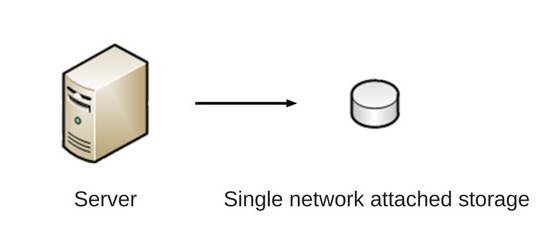NAS surveillance with Xeoma CCTV Software
NAS stands for Network-Attached Storage and is, in simple words, computer data storage server connected to a computer network and available for access from one or several computers in that network through file sharing protocols like NFS, AFP, etc.
There are special NAS drives in the market that are similar to other drives but may have different firmware, vibration tolerance, or power dispersion to make them more suitable for the purpose. A NAS unit usually has one or more storage drives, often organized into logical, redundant storage containers or RAID. When a RAID array is configured appropriately, the redundancy allowed for across the RAID set can aid in recovering a single bad block on a single drive without shutting down the drive completely.
NAS can be connected to a single computer in network or shared across several computers:

Picture 1. NAS connected to one computer

Picture 2. NAS connected to several computers
Over the years the demand for NAS surveillance has risen drastically, and so did the supply. Makers of all kinds of hardware have long discovered they should get a piece of the surveillance market by producing surveillance-aimed graphic cards, HDDs, switches, – and now it’s come to NAS surveillance units.
When speaking about NAS surveillance, generally 2 types are meant:
NAS as a CCTV storage
NAS can be used for intended purpose in surveillance area as well – as storage of video surveillance recordings, logs, settings, etc. Many video surveillance systems allow storage not just to on-premises drives but also to remote, off-site drives or array of drives like RAID – for security reasons.
The thing is video surveillance systems are mostly used as a detereent in most installations, and therefore their use is widely announced with special signs and cameras in plain sight. This strategy usually backfires: statistically, the first thing offenders steal or destroy is the video surveillance system itself. Keeping records off-site is a vital precaution in installations like this, where losing records is lethal.
An alternative to this kind of NAS surveillance is keeping records in remote Clouds – for example in cloud disks services like Google Disk, or full-featured VSaaS like Xeoma Cloud.
NAS as a standalone DVR
NAS can be used as a standalone video surveillance server (sometimes also called DVR NAS because of their being, among other things, basically digital video recorders).
The mechanics of DVR NAS is that in this case NAS comes not just as an array of drives, but also with a computer processing the disks, that has a processor, an operating system, and everything inherent to computers. You just install the video surveillance software inside the NAS computer like you do in regular computers.
Not every NAS comes with a computer unit, and not every surveillance solution can be installed to such NAS. NAS surveillance computers can have an Intel processor but most probably they have an ARM processor (for example, Marvell ARMADA lineup) which is another thing. In general, there are not so many video surveillance solutions that work with ARM NAS. Xeoma might be the only software with such wide set of functions to fully support ARM processors and work on devices like ARM-based NAS or micro computers like Raspberry Pi.
Despite higher cost, DVR NAS might prove more efficient and cost-effective considering there won’t be need in a separate computer when the NAS already has everything. All in all, this NAS surveillance option is certainly worth considering.
Why should you embed Xeoma to your NAS?
Conclusion:
NAS market is full of devices for various purposes; so if you’re looking for a NAS surveillance option you can rest assured there will be enough choice. You need to decide which type of NAS you want to go for – NAS storage or full NAS surveillance-aimed device with a computer unit – and off you go, shopping for the one for you.
June 6, 2018
Read also:
Xeoma’s system requirements calculator
Clustering in Xeoma VMS